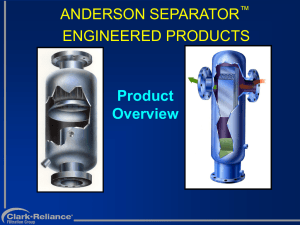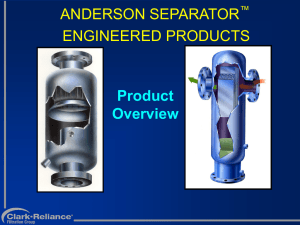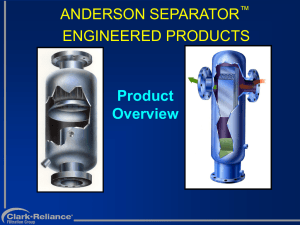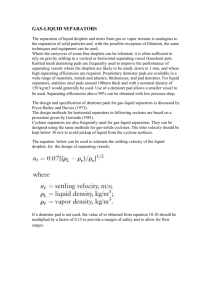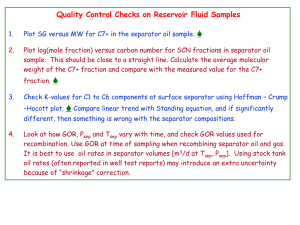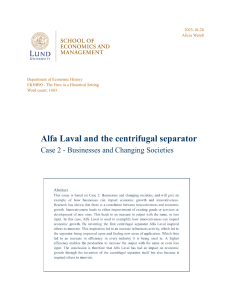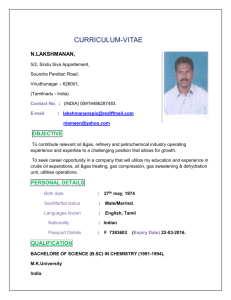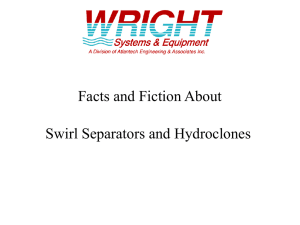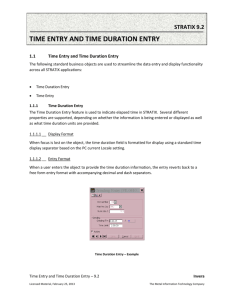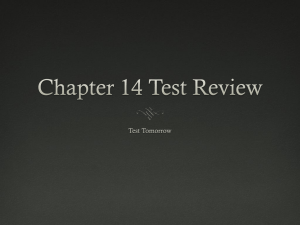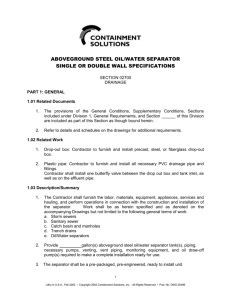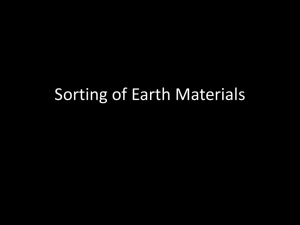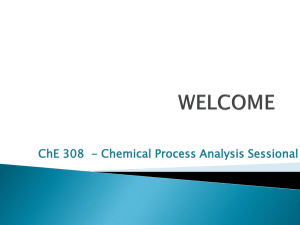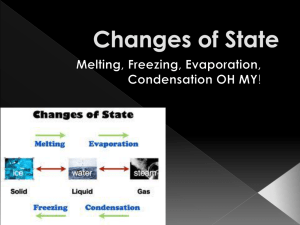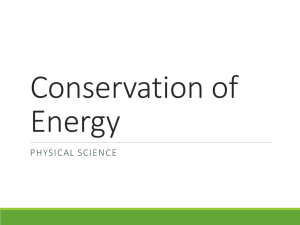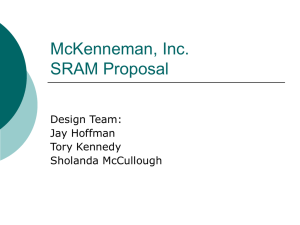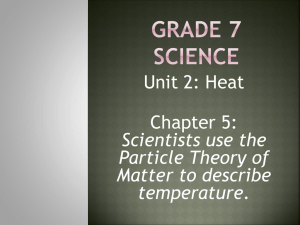anderson separator product line overview
advertisement
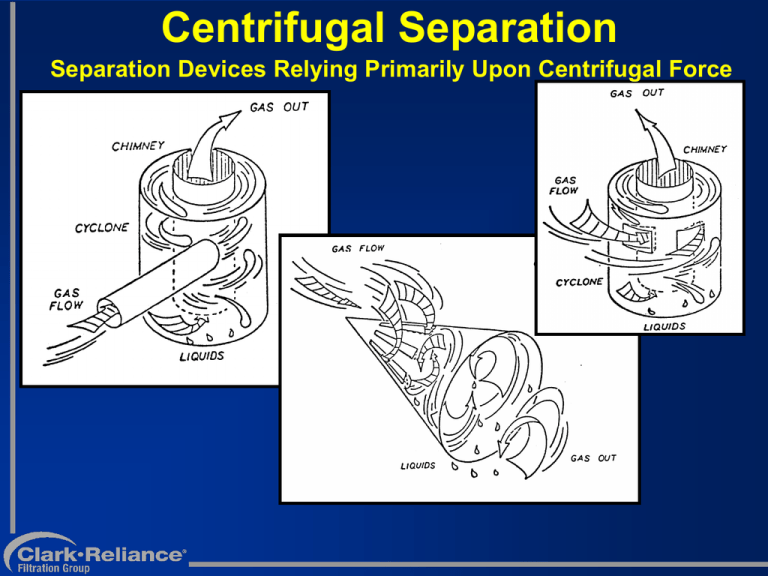
Centrifugal Separation Separation Devices Relying Primarily Upon Centrifugal Force Expected Efficiencies of Separation Methods METHOD EFFICIENIES Gravity 20 – 100 Microns Centrifugal 10 Micron Demister Pad 3 –10 Micron Vanes 3 – 8 Micron Filter Coalescer 0.3 Micron What is a Micron? 25.4 mm 25,400 MICRONS 1 MICRON .000039 INCH LOWEST LIMIT OF VISIBILITY (NAKED EYE) 40 MICRONS MICROSCOPIC 0.2 uM TO 40 uM ULTRA-MICROSCOPIC .001 uM to 0.2 uM Micron Basics -SIZE COMPARISON TABLES US SIEVE # MESH/INCH OPEN- INCH 50 52 .0117 70 72 .0083 100 101 .0059 140 143 .0041 200 200 .0029 270 270 .0021 325 323 .0017 400 --.0015 INCHES 1.0 0.0394 1/64 0.0000394 MILLIMETERS 25.4 1.0 -.001 OPEN-MICRON 297 210 149 105 74 53 44 37 MICRONS 25,400 1,000 400 1.0 Ultra Microscopic Microscopic Normal Eyesight Quiet Atmosphere Disturbed Atmosphere Tobacco Smoke FOG Rain Drop MIST Sea Salt N H4Cl Fumes Oil Smoke Virus & Protein Bacteria Dust Causing Lung Damage H2 SO4 Mist Rosin Smoke Carbon Black Sulfied Ore Spray-Dried Milk Pollens Ground Limestone Stoker Fly Ash SO3 Mist Pigments Oil Smoke Zinc Oxide Fumes Pulverized Coal Alkali Fumes Metallurgical Fumes Pulverized Coal Fly Ash Foundry Dust Cement Dust Metallurgical Dust Silica Streptococcus Pyogenes Talc Human Hair Blood Corpuscle Cyclone Separators ANDERSON Hi-EF AMCS - Multi-Cyclone AFS - Filter Separator ACF - Coalescing Filter .001 .01 0.1 0.3 1.0 3.0 5.0 10 100 1000 Microns Efficiency What do People Mean? - Percent Removal Rate i.e.. 99%, 99.5%, 100% - Total Removed by Count % Of Total Particles Of A Certain Range or Minimum Size. i.e. 99% of all particles 10 microns and larger. i.e. 100% of all liquid particles 8 microns and larger, and 100% of all solid particles 8 microns and larger. Anderson’s Centrifugal Type Separators • L and LC - Inline Separators Vertical Down Flow and Horizontal • TL - Inline Separators Horizontal Shorter face to face • 99% of 10 and Larger Liquid and Solid Particles Anderson’s Centrifugal Type Separators -Cont • Combination Separator Traps - 81S, HS, HSW - Inline • Exhaust Heads - Cast and Fabricated • BI - Internal Steam Drum Separator Anderson’s Centrifugal Type Separators - Cont. • AMCS - Multi-Cyclone Separator • Handles Heavy Solid Loadings • 100% of 8 and Larger Liquid Particles • 100% of 5 and Larger Solid Particles • 99% of 5 to 8 and Larger Liquid Particles L Type Centrifugal Separator • ASME Code Design Standard • 2-1/2 Inch to 12 Inch Flanged unit standard • Two Standard Models: -150 PSIG (10 BARG) @ 500 ºF (260 ºC) -300 PSIG (20 BARG) @ 500 ºF (260 ºC) • Horizontal & Vertical Down Flow (Vert. Down Flow Has Higher Liquid Capacities) • HI-EF Element Standard • Low Press Drop (<1 PSI, .01 BAR F-F) • Very Economical For ASME Code Unit • Popular w/ Air Compressors / Steam Systems / Refining • 99% of 10 : 2:1 TURNDOWN • Solids & Liquids • Maximum Entrainment: 5% By Weight LS Type Centrifugal Separator • “S” Stands For Special • Any Special Material 304, 316, and Exotics • Sizes Above 12” • Non Standard Pressures • Special Configurations • Mix & Match Elements • Popular w/ A&E Firms, OEMS • Same Efficiency: 99% 10 , 2:1 Typical Turndown. 5% by Weight Anderson’s Centrifugal Type Separators wet gas • HOW CENTRIFUGALS WORK • PERFORMANCE • QUICK SIZING Clean Gas AMCS Multi-Cyclone Centrifugal Separator • Nested Multi-Cyclone Elements. • Excellent For Dry Only, Low Maintenance • Efficiency: 100% of 5 Solids, 100% of 8 Liquids. • Versus HI-EF Centrifugal: More Efficient But Higher P (2-3 PSID OVERALL) • Basic Design No Slugging, MAX 5% Liquid/Solids by Weight • High Liquid Capacity Models Available AMCS Multi-Cyclone Centrifugal Separator AMCS Multi-Cyclone Centrifugal Separator Required Information • The Big Picture • Gas • Flow Rate • Removal of What? • Slugging / High Solids • Required Removal Efficiency • Minimum / Maximum Operating Pressure • Minimum / Maximum Operating Temp. Required Information • Pressure Drop • Arrangement • Connections • Materials • ASME Code Information Instrumentation Gage Glass Liquid Level Controller Liquid Level Switches Dump Valves Pressure / Temp. Gauges Relief Valves P Indicators and Transmitters Conclusion • Separators are critical pieces of equipment for the smooth operation of most all processes. • Different applications require different approaches, different styles of separators, and sometimes units in combination. • IT IS IMPORTANT TO GET ALL THE INFORMATION CORRECT THE FIRST TIME-- SAVES TIME AND $$ More Than Just A Separator. . . Systems Design & Integration Filtration Services Equipment Design & Manufacturing ® ®
